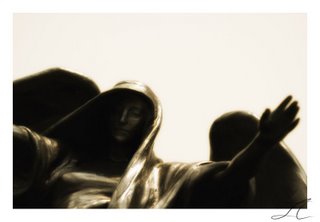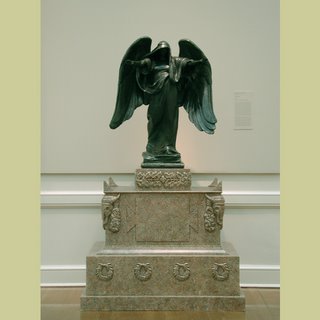
ben-e-dic-tion n. 1. a blessing
I recently took a trip to The Huntington to spend some time walking the gardens and viewing the art collections. The nice thing about living so close to a place like The Huntington is the chance to spend quality time. There is no need to rush through and visit all of the gardens or all of the exhibits in one day. Instead, you can go for tea and then visit the Shakespeare Garden. Come back another day and visit the Japanese Garden and the Chinese Art Exhibit. This particular trip I went for tea, visited the Japanese Garden, and then spent a fair amount of time in the Scott Gallery and the Erburu Gallery viewing some very famous American and European paintings by artists such as Edward Hopper, Mary Cassatt, Gainsborough and Reynolds.

Though I enjoyed these paintings, I was most intrigued with a bronze sculpture titled Benediction, by Daniel Chester French. French is perhaps most famous for his sculpture of Abraham Lincoln that stands (or rather sits) in the Lincoln Memorial.
 Benediction "was modeled in 1922.... A sixteen-foot version of Benediction was to have been the centerpiece of a monument near St. Mihiel, France, honoring soldiers from Massachusetts who had died in the First World War. The shrouded, winged figure, a recurring image in French's work, would have hovered high above the recumbent figure of a soldier covered by an American flag, offering a final blessing. Neither the monument, ... nor the full-scale sculpture, was ever made, though four smaller versions of Benediction, including [the one at The Huntington], are known to exist."
Benediction "was modeled in 1922.... A sixteen-foot version of Benediction was to have been the centerpiece of a monument near St. Mihiel, France, honoring soldiers from Massachusetts who had died in the First World War. The shrouded, winged figure, a recurring image in French's work, would have hovered high above the recumbent figure of a soldier covered by an American flag, offering a final blessing. Neither the monument, ... nor the full-scale sculpture, was ever made, though four smaller versions of Benediction, including [the one at The Huntington], are known to exist."This sculpture, on its base, stands perhaps 7 feet high. I was intrigued at first glance since the sculpture appears a bit ominous with its shrouded figure and dark bronze coloring. I moved on to take a look at a few other sculptures in the room and found myself back at Benediction for another look. This time I got down low to the ground and looked up into the face of this angel with outstretched arms and noticed the peaceful look of blessing. I could hardly breathe for the emotion that this drew. I then moved into another room to look at some paintings, but found myself returning to stare at Benediction some more. At the third (and not last) visit to this sculpture that continuously drew me back, I began imagining what it would have looked like at its full 16 foot height, not including the large base that it would have required. The power and beneficence that this sculpture would have exuded as it hovered over a flag draped fallen soldier would have been enormous. I am sorry that the monument and full-scale sculpture were never executed.
It is rare that I experience this kind of reaction to a piece of art. I have been drawn to various pieces in the past, but never this powerfully. I am a reader, and sometime writer, who easily recognizes the great power of words. This visit to The Huntington reminded me of the great power of images.
For those who have an interest in photography, I encourage you to visit Leo Chen's website. He has some amazing photos on display. As I searched around for images of Benediction, the only ones I found that came close to capturing what I felt as I viewed this sculpture were the two Chen photos presented in this post.
Maybe the power of the statue lies in the fact that it is incomplete - that you are called upon to imagine how awe-inspiring it would be at its full height.
ReplyDeleteB&P, yes I would agree that some of its power lies in my own imaginings of its intended size. I was also drawn by the bit of juxtaposition between the action of benediction and the rather ominous shrouding and dark coloring. Many of these types of sculptures are done in a light colored marble.
ReplyDeleteYes this has been my favorite sculpture of all the works here at Brook green Gardens. It evokes a very powerfull emotion linked to something greater than our understanding.
ReplyDelete